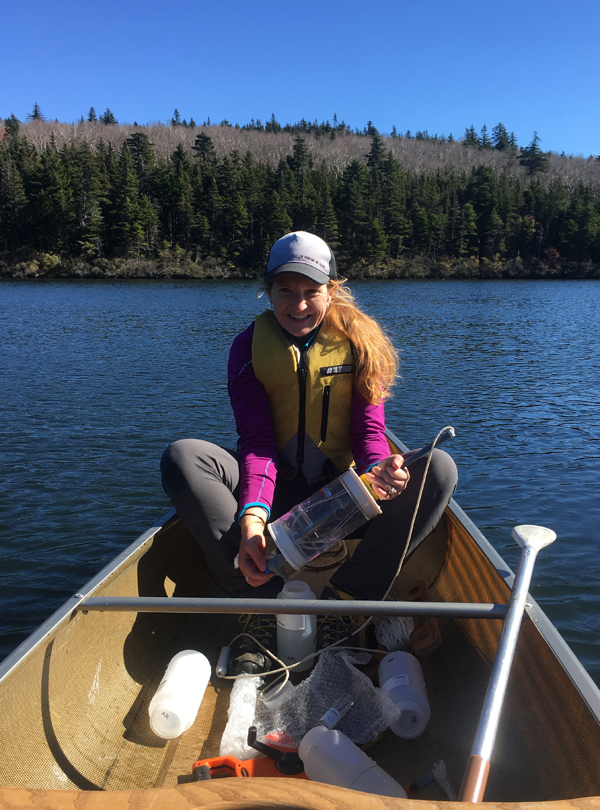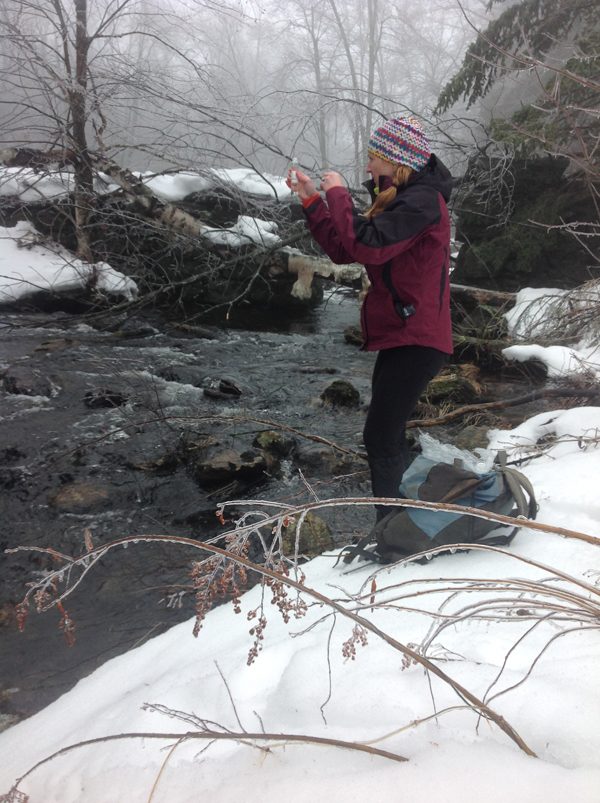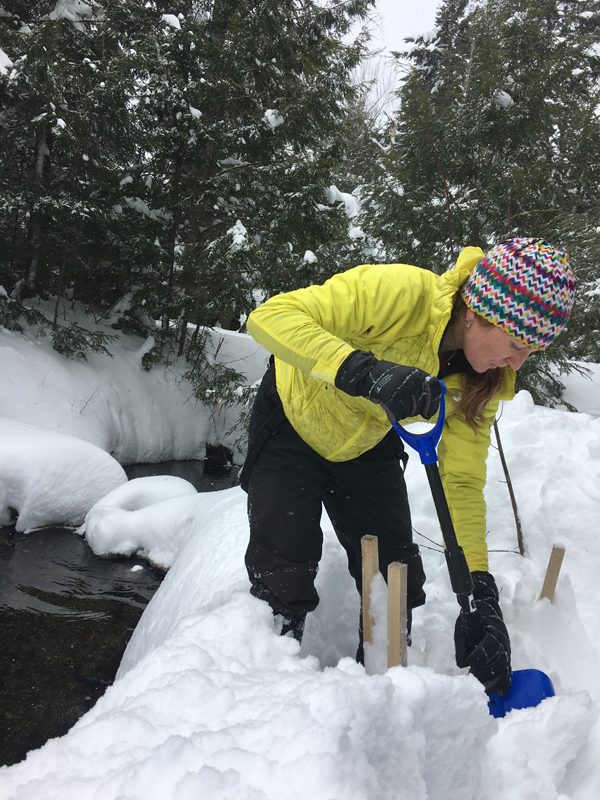Acid Rain Data Helping Scientists Tackle Water Quality Issues

Dr. Harvey readies the equipment. (Credit: Dr. Harvey, via communication.)
Since the 1980s, scientists from the Vermont Department of Environmental Conservation (VT DEC) have been sampling water from acid-impaired ponds and lakes and tracking data related to acidity. The line of inquiry began in response to concerns about acid rain, but DEC scientists now find that the long-term monitoring is not only proving the efficacy of the Clean Air Act but also improving local water quality.
Guarding the environment in Vermont
Rebecca Harvey is a VT DEC scientist, and monitoring the state’s waterways for acidity and other problems falls in part to her. Dr. Harvey corresponded with EM about this work.
“Vermont is relatively pristine compared to other areas of the country and world, and we (VT DEC) are working very hard to keep it that way,” explains Dr. Harvey. “We do have lakes and ponds that are threatened by nutrient loading due to land use, but these nutrient levels are generally still much lower than those measured in lakes/ponds in more heavily populated or farmed areas. We are also observing some interesting trends that seem to suggest that our most pristine lakes are declining in water quality at a greater rate than higher nutrient lakes, which is also of concern and suggests that we need to invest more resources in protecting those areas before we lose them.”
The VT DEC has been sampling from lakes and ponds and analyzing samples taken for decades. The Vermont Long Term Monitoring (VLTM) Program was established in the winter of 1979/1980 in response to trends in acidification across the northeast.
“The three main objectives of the program were to 1. determine the current chemical characteristics of the study lakes, 2., estimate seasonal and annual variability in chemical characteristics, and 3. investigate long-term changes in chemical characteristics,” Dr. Harvey describes. “By 1982, 184 lakes had been chemically surveyed. From this preliminary screening, 36 lakes were chosen to be chemically monitored on a long-term basis.”
The VT DEC also completed fish and macroinvertebrate surveys in 1983 and 1987, respectively, on a subset of these ponds. By 1988, limitations in resources mandated that the program be reduced to 25 ponds, and again in 1993, the number dropped, this time to 12 ponds. These 12 ponds are still monitored by the VT DEC at least three times per year.
“Initially, the program monitored pH, gran alkalinity, color, Secchi disk transparency and conductivity, but as we have learned more about recovery from acidification and as our analytical tools have improved, we’ve since added dissolved ions (Ca2+ Mg2+ , Na+ , K+, Al, SO42-, NO3– and Cl), silica, total phosphorus, speciated aluminum, and dissolved organic/inorganic carbon (DOC and DIC), to the suite of chemical analyses that we perform,” Dr. Harvey details. “Simultaneously, sister programs were initiated in the late 1970s that focused on monitoring nutrients in Lake Champlain and lower elevation ‘in-land’ lakes throughout Vermont.”
Sampling water all over the state
Dr. Harvey works hard to get the samples she needs. Each site was selected decades ago, and this consistent sampling has allowed the VT DEC to accumulate years of data about each remote location.
“Sampling locations were established when the program was developed in the 1980s,” clarifies Dr. Harvey. “The idea was to focus on lakes that were only impacted by atmospheric deposition and no other anthropogenic impacts such as roads, housing, ski areas, or logging. We sample ponds that are determined to be particularly sensitive to acid precipitation; they are at high elevation and within watersheds dominated by soils and bedrock geology that have low buffering capacity.”

Taking a water sample. (Credit: Dr. Harvey, via communication.)
During the winter, she uses cross-country skis to access some sampling sites, and some ponds are frozen over. These remote sites offer data that aren’t affected by agricultural runoff, road salt, or any other pollutants inherent to more developed areas. It’s worth the trouble of clambering out to these areas, even in cold weather, because winter and early spring data offers valuable insights to the VT DEC, revealing how much acid is entering waterways as the snowpack melts.
“Over the course of the winter, snow and pollutants carried on prevailing winds deposit and build up on the snowpack,” remarks Dr. Harvey. “In the spring, as temperatures rise and rain melts the snowpack, that accumulation of acidic pollutants hits the lakes and streams over a short period of time. This can cause a quick depression of the pH during a vulnerable time of the year for aquatic life.”
These drastic changes in acidity can have serious impacts on the fish and other aquatic life in these waterways.
There is a unique protocol for sampling during each season.
“During the summer (the stratified period), we sample both the epilimnion and hypolimnion at the deepest point of the lake,” states Dr. Harvey. “During the fall we sample 1 meter deep only after the lake has mixed (also at the deepest point of the lakes), and during the spring we sample at a depth of 1 meter, before the lake has stratified (also at the deepest point). In the spring we also sample the outlets of 7 of the core 12 ponds.”
The right tools for the job
Dr. Harvey and the other members of the VT DEC team are helping to implement a monitoring plan that started decades ago, but they are doing so with the help of newer technologies. For example, during the spring Dr. Harvey works to capture the “acid shock” from melting snow with an automatic sampler.
“We use an ISCO sampler, which is a widely used automatic sampler,” explains Dr. Harvey. “It has a pneumatic pump that samples a known volume from the outlet at known frequency. We have it set up to sample 500 mL every 48 hours at ~noon, but it is fully customizable to sample at whatever frequency the user decides. I visit the sampler about once per week to collect the samples.”
At times the most important equipment for Dr. Harvey is whatever helps get her to the sampling site—and sampling equipment she can port there with her.
“Many of our ponds are not easily accessible and require up to 45-60 min of hiking to reach them,” Dr. Harvey details. “We use an inflatable raft to access the deepest point of the lake in these cases. We use a Kemmerer to sample at discrete depths in the lake. We collect temperature and conductivity depth profiles using a hand-held YSI meter. During the springtime, we also use a Hydrolab multiprobe with a DO and pH sensor to measure DO/pH profiles.”
Once back at the lab, Dr. Harvey and the team analyze some samples themselves and send others out for analysis.
“We perform some analyses ourselves, including measuring pH with a probe, the acid neutralizing capacity using the Gran titration method, absorbance at 420 nm with a spectrophotometer and color using a visual color comparator,” describes Dr. Harvey. “Otherwise, our samples go to the state-run Vermont Agricultural and Environmental Laboratory (VAEL). VAEL is an EPA-certified lab run by state chemists and use an ion chromatograph for dissolved ions, an ICP-MS for metals (including speciated aluminum) and total carbon analyzer for DOC and DIC. We also send split samples to the University of Maine Sawyer Environmental and Research Laboratory for DOC and speciated aluminum.”
A rich cache of data protecting the “airshed”
With such a rich store of data, the VT DEC has a range of options for using it. They have plans in the works for modeling and other data-driven projects.
“We do have an expansive data set, and the opportunities for research are limitless,” remarks Dr. Harvey. “We have been focusing on teasing out long-term trends for key chemical and physical parameters recently and have also contributed our data to global initiatives. Our current goal is to use these data to better understand recovery processes in our lakes and ponds.”

Working in the field. (Credit: Dr. Harvey, via communication.)
One potentially powerful use for the data is allowing for comparisons with watersheds with more anthropogenic impacts since these waterways are so pristine. Other than what falls from the sky, these ponds have very few inputs changing their chemistries.
“They can serve as models of the water quality status of lakes had development never occurred,” states Dr. Harvey. “This lack of anthropogenic influence (besides atmospheric deposition) also allows for interesting comparisons to be made, and for us to investigate the impacts of climate change.”
Dr. Harvey has also been working with a DEC statistician and modeler to deal with the problem of censored data.
“The concentration of ions in acid lakes tends to be small, so we can get results that are reported as ‘<‘ the detection limit, such as nitrate and potassium,” explains Dr. Harvey. “Other times, a data point is missing altogether. To conduct robust trends analysis, we have calculated substitution values that will have the least likelihood to skew the data. Dealing with censored data appropriately is very important yet often gets little consideration by long-term monitoring programs. Improper use of censored data can introduce alien trends and false summary statistics.”
Of course, more research and data often prompts more lines of inquiry. “Acidification is also a very complex chemical process, the more we come to understand it, the more questions we have,” adds Dr. Harvey.
One of the issues that the decades of data have clarified for Dr. Harvey is the issue of seeing pollution within the big picture.
“Air pollution doesn’t care about political boundaries, in thinking about acid precipitation and its impacts on terrestrial and water surfaces,” Dr. Harvey states. “So we need to look at the big picture (spatially) and think in terms of ‘airsheds,’ analogous to ‘watersheds.’”
Top image: Dr. Harvey readies the equipment. Credit: Dr. Harvey, via communication.




Pingback: Acid Rain Data Helping Scientists Tackle Water Quality Issues - Lake Scientist